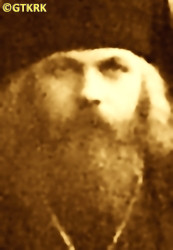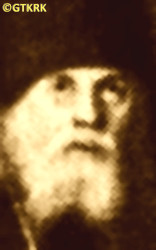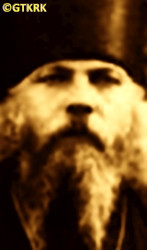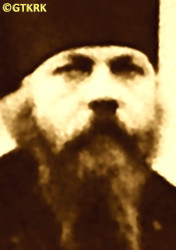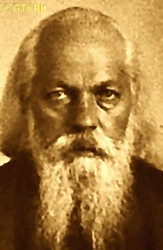Roman Catholic
St Sigismund parish
05-507 Słomczyn
85 Wiślana Str.
Konstancin deanery
Warsaw archdiocese, Poland
full list:
displayClick to display full list

searchClick to search full list by categories
wyświetlKliknij by wyświetlić pełną listę po polsku

szukajKliknij by przeszukać listę wg kategorii po polsku

Martyrology of the clergy — Poland
XX century (1914 – 1989)
personal data
surname
MALUTA
forename(s)
Dennis (pl. Dionizy)
religious forename(s)
Damaskinos (pl. Damaskin)

function
archbishop
creed
Eastern Orthodox Church ORmore on
en.wikipedia.org
[access: 2014.09.21]
diocese / province
Volyn‐Podilsky OR eparchy (Ukrainian Autonomous Orthodox Church UAOC)more on
drevo-info.ru
[access: 2023.08.19]
Kamyanets‐Podilskyi OR eparchy (Ukrainian Autonomous Orthodox Church UAOC)more on
drevo-info.ru
[access: 2023.08.19]
Vinnytsia‐Podilsky OR eparchy (Ukrainian Autonomous Orthodox Church UAOC)more on
drevo-info.ru
[access: 2023.08.19]
Chernivtsi‐Khotyn OR eparchymore on
drevo-info.ru
[access: 2023.08.19]
Zhytomyr OR eparchymore on
drevo-info.ru
[access: 2023.08.19]
nationality
Ukrainian
date and place
of death
1946

ITL SibLagGuLAG slave labour camp network
today: n. Omsk, Omsk oblast, Russia
more on
ru.wikipedia.org
[access: 2024.01.29]
alt. dates and places
of death
1946 (after)
details of death
After the outbreak of World War I in 1914, ministered as a chaplain at the Red Cross Hospital in Chernihiv. In 1915, after the Russian defeat in 05.1915 in the Battle of Gorlice, evacuated with the monks from the Lavra in Pochaiv to the east (the so‐called bezhenstvo), initially to Kiev.
After the German and Russian invasion of Poland in 09.1939 and the start of World War II, after the start of the Russian occupation, interrogated in 03.1940 by agents of the Russian genocidal organization NKVD in Kovel. Under pressure, agreed to cooperate with the NKVD, but in practice did not do so.
After the end of the German occupation, which started after the attack on 22.06.1941 on their erstwhile ally, the Russians, and the entry of Russian troops in Kamyanets–Podilskyi in 03.1944, arrested there on 18.05.1944 by the NKVD.
Transferred to prison No. 1 in Kiev.
There, on 25.10.1944, stood before a military cangaroo court of the genocidal NKVD (it is not known whether was present himself at the trial). Accused, among others of „transferring information to the German occupation authorities about the activities of the split Orthodox Church; […] systematic preaching of anti–Russian (anti–Soviet) sermons; […] slanderous insults about the leaders of the October Revolution; […] presenting a vulgarized version of dialectical materialism; […] cooperation with counter–revolutionary organizations seeking to overthrow Soviet power and establish a monarchical system in Russia”.
Sentenced to 15 years of slave labor in Russian Gulag concentration camps.
Transported to one of the camps of the ITL SibLag concentration camp complex near Omsk, where perished.
cause of death
extermination
perpetrators
Russians
sites and events
ITL SibLagClick to display the description, GulagClick to display the description, Kiev (Lyukyanivska)Click to display the description, Ribbentrop‐MolotovClick to display the description
date and place
of birth
23.05.1883

Klebantoday: Kleban hrom., Tulchyn rai., Vinnytsia obl., Ukraine
more on
uk.wikipedia.org
[access: 2023.08.19]
parents
MALUTA Macarius
🞲 ?, ? — 🕆 ?, ?

🞲 ?, ? — 🕆 ?, ?
religious vows
04.1910 (permanent)
presbyter (holy orders)
ordination
1913

positions held
06.06.1943 – 05.1944
bishop — Ukrainian Autocephalous Orthodox Church UAOC ⋄ Volyn‐Podilsky OR eparchy — there is uncertainty whether the Ukrainian Autocephalous Orthodox Church UACP still formally existed; referred to as „Bishop Senior”, as requested by the Germans
06.06.1943 – 05.1944
rector — Pochaivtoday: Pochaiv urban hrom., Kremenets rai., Ternopil obl., Ukraine
more on
en.wikipedia.org
[access: 2020.09.27] ⋄ Polish Autocephalous Orthodox Church PACP ⋄ Dormition of the Mother of God OR monastery (Pochaiv Lavra)
1943 – 1944
bishop — Ukrainian Autocephalous Orthodox Church UAOC ⋄ Kamyanets‐Podilskyi OR eparchy — Lat. locum tenens (Eng. „holding reins”), acting („ad interim”)
06.06.1943
archbishop — Koveltoday: Kovel urban hrom., Kovel rai., Volyn obl., Ukraine
more on
en.wikipedia.org
[access: 2021.12.19] ⋄ Ukrainian Autocephalous Orthodox Church UAOC — dignity conferment
11.1941 – 06.06.1943
bishop — Kamyanets‐Podilskyitoday: Kamyanets‐Podilskyi urban hrom., Kamyanets‐Podilskyi rai., Proskuriv/Khmelnytskyi obl., Ukraine
more on
en.wikipedia.org
[access: 2021.09.17] ⋄ Ukrainian Autocephalous Orthodox Church UAOC ⋄ Vinnytsia‐Podilsky OR eparchy
03.1941 – 11.1941
bishop — ChernivtsiBukovina region
today: Chernivtsi urban hrom., Chernivtsi rai., Chernivtsi obl., Ukraine
more on
en.wikipedia.org
[access: 2020.11.20] ⋄ Russian Orthodox Church ⋄ Chernivtsi‐Khotyn OR eparchy — on 20.08.1941, after the German attack on 22.06.1941 on their erstwhile ally, the Russians, and the start of the German occupation, joined the Ukrainian Autocephalous Orthodox Church UAOC
22.08.1940 – 03.1941
bishop — Zhytomyrtoday: Zhytomyr urban hrom., Zhytomyr rai., Zhytomyr obl., Ukraine
more on
en.wikipedia.org
[access: 2021.09.17] ⋄ Russian Orthodox Church ⋄ Zhytomyr OR eparchy — from 28.10.1940, a member of the Exarchate of Western Ukraine, established, among others, by in the Russian–occupied part of Poland
22.08.1940
Bishop — Moscowtoday: Moscow city, Russia
more on
en.wikipedia.org
[access: 2020.07.31] ⋄ Russian Orthodox Church ⋄ Epiphany of the Lord OR cathedral church — bishop's cheirotonia, i.e. ordination
12.1935 – 1940
rector — Koveltoday: Kovel urban hrom., Kovel rai., Volyn obl., Ukraine
more on
en.wikipedia.org
[access: 2021.12.19] ⋄ Our Lord's Resurrection OR cathedral church ⋄ Koveltoday: Kovel urban hrom., Kovel rai., Volyn obl., Ukraine
more on
en.wikipedia.org
[access: 2021.12.19] OR deanery — also: prefect of a school for girls, chairman of the Orthodox District Committee
10.1932 – 12.1935
rector — Meltsitoday: Sokolyshche hrom., Stara Vyzhivka rai., Volyn obl., Ukraine
more on
uk.wikipedia.org
[access: 2023.07.16] ⋄ Polish Autocephalous Orthodox Church PACP ⋄ St Nicholas OR monastery
02.1932 – 10.1932
rector — Dubnotoday: Dubno urban hrom., Dubno rai., Rivne obl., Ukraine
more on
en.wikipedia.org
[access: 2020.11.27] ⋄ Orthodox monastic community, Polish Autocephalous Orthodox Church PACP
c. 1925 – 1928
student — Warsawtoday: Warsaw city pov., Masovia voiv., Poland
more on
en.wikipedia.org
[access: 2021.10.09] ⋄ Orthodox Theology Department, University of Warsaw [i.e. University of Warsaw (from 1945) / clandestine University (1939‐1945) / Joseph Piłsudski University (1935‐1939) / University of Warsaw (1915‐1935) / Imperial University of Warsaw (1870‐1915)] — postgraduate specialised studies, prob. crowned with the title of master of sacred Orthodox theology
08.1920 – 02.1932
rector — Pochaivtoday: Pochaiv urban hrom., Kremenets rai., Ternopil obl., Ukraine
more on
en.wikipedia.org
[access: 2020.09.27] ⋄ Polish Autocephalous Orthodox Church PACP ⋄ Dormition of the Mother of God OR monastery (Pochaiv Lavra) — from 1921, dean/guardian of all the monasteries of the Volyn–Zhytomyr eparchy; from 1923 also overseer of the St Onuphrius monastery in Jabłeczna
08.1920
Archimandrite, i.e. superior abbot — Pochaivtoday: Pochaiv urban hrom., Kremenets rai., Ternopil obl., Ukraine
more on
en.wikipedia.org
[access: 2020.09.27] ⋄ Russian Orthodox Church ⋄ Dormition of the Mother of God OR monastery (Pochaiv Lavra) — dignity conferment
1919 – 08.1920
hieromonk — Pochaivtoday: Pochaiv urban hrom., Kremenets rai., Ternopil obl., Ukraine
more on
en.wikipedia.org
[access: 2020.09.27] ⋄ Russian Orthodox Church ⋄ Dormition of the Mother of God OR monastery (Pochaiv Lavra) — preacher, member of Lavra Spiritual Council
1918
student — Kievtoday: Kiev city rai., Kiev city obl., Ukraine
more on
en.wikipedia.org
[access: 2023.03.02] ⋄ Orthodox Theological Academy — for about three months, studies interrupted due to the political situation
1915 – 10.1918
hieromonk — Zhytomyrtoday: Zhytomyr urban hrom., Zhytomyr rai., Zhytomyr obl., Ukraine
more on
en.wikipedia.org
[access: 2021.09.17] ⋄ Orthodox monastic community, Russian Orthodox Church — treasurer and confessor; also: student of Pastoral School
1915
hieromonk — Svyatogorsktoday: Svyatogorsk urban hrom., Kramatorsk rai., Donetsk obl., Ukraine
more on
en.wikipedia.org
[access: 2023.08.19] ⋄ Russian Orthodox Church ⋄ Dormition of the Mother of God OR monastery (Svyatogorsk)
1914
hieromonk — Pochaivtoday: Pochaiv urban hrom., Kremenets rai., Ternopil obl., Ukraine
more on
en.wikipedia.org
[access: 2020.09.27] ⋄ Russian Orthodox Church ⋄ Dormition of the Mother of God OR monastery (Pochaiv Lavra) — priesthood cheirotonia, i.e. ordination
1911
hierodeacon — Pochaivtoday: Pochaiv urban hrom., Kremenets rai., Ternopil obl., Ukraine
more on
en.wikipedia.org
[access: 2020.09.27] ⋄ Russian Orthodox Church ⋄ Dormition of the Mother of God OR monastery (Pochaiv Lavra) — diaconate cheirotonia, i.e. ordination
04.1910
monk — Pochaivtoday: Pochaiv urban hrom., Kremenets rai., Ternopil obl., Ukraine
more on
en.wikipedia.org
[access: 2020.09.27] ⋄ Russian Orthodox Church ⋄ Dormition of the Mother of God OR monastery (Pochaiv Lavra) — adoption of the tonsure and perpetual monastic vows
04.1910 – 1914
head/manager — Pochaivtoday: Pochaiv urban hrom., Kremenets rai., Ternopil obl., Ukraine
more on
en.wikipedia.org
[access: 2020.09.27] ⋄ Icon Painting School, Russian Orthodox Church ⋄ Dormition of the Mother of God OR monastery (Pochaiv Lavra)
1903 – 04.1910
probationer (Rus. Poslushnik) — Pochaivtoday: Pochaiv urban hrom., Kremenets rai., Ternopil obl., Ukraine
more on
en.wikipedia.org
[access: 2020.09.27] ⋄ Icon Painting School, Russian Orthodox Church ⋄ Dormition of the Mother of God OR monastery (Pochaiv Lavra) — from 11.05.1908 head of icon painting workshop
1899 – 23.04.1903
student — Athostoday: Athos autonomous region, Greece
more on
en.wikipedia.org
[access: 2023.08.19] ⋄ Icon Painting School, Orthodox Patriarchate of Constantinople ⋄ OR monastery — from 03.04.1900 an probationer (Rus. Poslushnik) preparing for the monastic state (gave 1880 as the date of birth), taking the vows of obedience to writing icons
sites and events
descriptions
ITL SibLag: Russian Rus. Исправи́тельно‐Трудово́й Ла́герь (Eng. Corrective Labor Camp) ITL Rus. Сибирский (Eng. Siberian) — concentration and slave forced labor camp (within the Gulag complex) — headquartered in Mariinsk in Kemerovo Oblast, where a central camp for invalids was also operational (moved twice to Novosibirsk, c. 350 km away). Founded in 1929. One of the largest — initially spread over large area from Omsk to Krasnoiarsk, as a matter of fact whole Western Siberian Plain, next subdivided and limited to Novosibirsk, Tomsk and Kemerovo oblasts. Up to 80,000 inmates were held in SibLag: e.g. 78,838 (01.01.1938); 77,919 (01.01.1942); 70,370 (01.04.1942). Prisoners slaved at railroad construction, forestry, carpentry and in coal mines, and other industrial branches (brick, clothing, leather and fur factories and plants). Closed down in c. 1960. (more on: tspace.library.utoronto.caClick to attempt to display webpage
[access: 2018.09.02], www.gulagmuseum.orgClick to attempt to display webpage
[access: 2014.05.09])
Gulag: The acronym Gulag comes from the Rus. Главное управление исправительно‐трудовых лагерей и колоний (Eng. Main Board of Correctional Labor Camps). The network of Russian concentration camps for slave labor was formally established by the decision of the highest Russian authorities on 27.06.1929. Control was taken over by the OGPU, the predecessor of the genocidal NKVD (from 1934) and the MGB (from 1946). Individual gulags (camps) were often established in remote, sparsely populated areas, where industrial or transport facilities important for the Russian state were built. They were modeled on the first „great construction of communism”, the White Sea‐Baltic Canal (1931‐1932), and Naftali Frenkel, of Jewish origin, is considered the creator of the system of using forced slave labor within the Gulag. He went down in history as the author of the principle „We have to squeeze everything out of the prisoner in the first three months — then nothing is there for us”. He was to be the creator, according to Alexander Solzhenitsyn, of the so‐called „Boiler system”, i.e. the dependence of food rations on working out a certain percentage of the norm. The term ZEK — prisoner — i.e. Rus. заключенный‐каналоармец (Eng. canal soldier) — was coined in the ITL BelBaltLag managed by him, and was adopted to mean a prisoner in Russian slave labor camps. Up to 12 mln prisoners were held in Gulag camps at one time, i.e. c. 5% of Russia's population. In his book „The Gulag Archipelago”, Solzhenitsyn estimated that c. 60 mln people were killed in the Gulag until 1956. Formally dissolved on 20.01.1960. (more on: en.wikipedia.orgClick to attempt to display webpage
[access: 2024.04.08])
Kiev (Lyukyanivska): Russian political prison in Kiev, in the first half of 20th century run by the genocidal NKVD, informally referred to as prison No 1, formally as Investigative Prison No 13 (SIZO#13). It was founded in the early 19th century. In the 20th century, during the Soviet times, the prison church was transformed into another block of cells. During the reign of J. Stalin in Russia, more than 25,000 prisoners passed through it. (more on: en.wikipedia.orgClick to attempt to display webpage
[access: 2014.09.21])
Ribbentrop‐Molotov: Genocidal Russian‐German alliance pact between Russian leader Joseph Stalin and German leader Adolf Hitler signed on 23.08.1939 in Moscow by respective foreign ministers, Mr. Vyacheslav Molotov for Russia and Joachim von Ribbentrop for Germany. The pact sanctioned and was the direct cause of joint Russian and German invasion of Poland and the outbreak of the World War II in 09.1939. In a political sense, the pact was an attempt to restore the status quo ante before 1914, with one exception, namely the „commercial” exchange of the so‐called „Kingdom of Poland”, which in 1914 was part of the Russian Empire, fore Eastern Galicia (today's western Ukraine), in 1914 belonging to the Austro‐Hungarian Empire. Galicia, including Lviv, was to be taken over by the Russians, the „Kingdom of Poland” — under the name of the General Governorate — Germany. The resultant „war was one of the greatest calamities and dramas of humanity in history, for two atheistic and anti‐Christian ideologies — national and international socialism — rejected God and His fifth Decalogue commandment: Thou shall not kill!” (Abp Stanislav Gądecki, 01.09.2019). The decisions taken — backed up by the betrayal of the formal allies of Poland, France and Germany, which on 12.09.1939, at a joint conference in Abbeville, decided not to provide aid to attacked Poland and not to take military action against Germany (a clear breach of treaty obligations with Poland) — were on 28.09.1939 slightly altered and made more precise when a treaty on „German‐Russian boundaries and friendship” was agreed by the same murderous signatories. One of its findings was establishment of spheres of influence in Central and Eastern Europe and in consequence IV partition of Poland. In one of its secret annexes agreed, that: „the Signatories will not tolerate on its respective territories any Polish propaganda that affects the territory of the other Side. On their respective territories they will suppress all such propaganda and inform each other of the measures taken to accomplish it”. The agreements resulted in a series of meeting between two genocidal organization representing both sides — German Gestapo and Russian NKVD when coordination of efforts to exterminate Polish intelligentsia and Polish leading classes (in Germany called «Intelligenzaktion», in Russia took the form of Katyń massacres) where discussed. Resulted in deaths of hundreds of thousands of Polish intelligentsia, including thousands of priests presented here, and tens of millions of ordinary people,. The results of this Russian‐German pact lasted till 1989 and are still in evidence even today. (more on: en.wikipedia.orgClick to attempt to display webpage
[access: 2015.09.30])
sources
personal:
www.pstbi.ccas.ruClick to attempt to display webpage
[access: 2023.08.19], drevo-info.ruClick to attempt to display webpage
[access: 2023.08.19], ru.openlist.wikiClick to attempt to display webpage
[access: 2023.08.19], ru.wikipedia.orgClick to attempt to display webpage
[access: 2023.08.19]
bibliographical:
„Hierachy, clergy and employees of the Orthodox Church in the 19th‐21st centuries within the borders of the Second Polish Republic and post–war Poland”, Fr Gregory Sosna, M. Antonine Troc-Sosna, Warsaw–Bielsk Podlaski 2017
original images:
drevo-info.ruClick to attempt to display webpage
[access: 2023.08.19], www.pstbi.ccas.ruClick to attempt to display webpage
[access: 2023.08.19], ru.wikipedia.orgClick to attempt to display webpage
[access: 2023.08.19], afonit.infoClick to attempt to display webpage
[access: 2023.08.19], drevo-info.ruClick to attempt to display webpage
[access: 2023.08.19], drevo-info.ruClick to attempt to display webpage
[access: 2023.08.19], drevo-info.ruClick to attempt to display webpage
[access: 2023.08.19]
LETTER to CUSTODIAN/ADMINISTRATOR
If you have an Email client on your communicator/computer — such as Mozilla Thunderbird, Windows Mail or Microsoft Outlook, described at WikipediaPatrz:
en.wikipedia.org, among others — try the link below, please:
LETTER to CUSTODIAN/ADMINISTRATORClick and try to call your own Email client
If however you do not run such a client or the above link is not active please send an email to the Custodian/Administrator using your account — in your customary email/correspondence engine — at the following address:

giving the following as the subject:
MARTYROLOGY: MALUTA Dennis
To return to the biography press below:
 Click to return to biography
Click to return to biography








